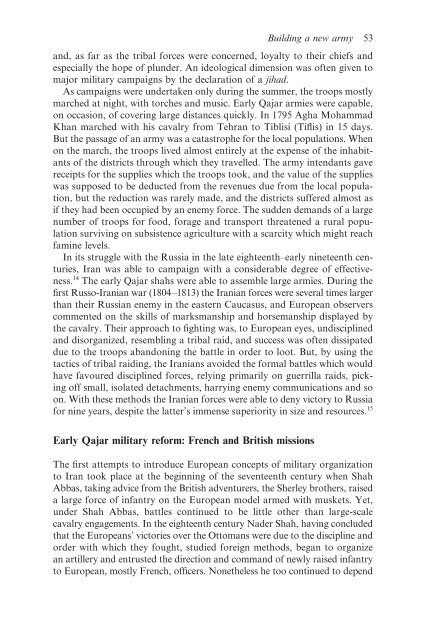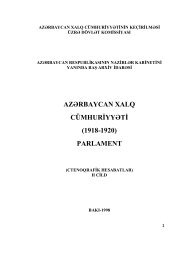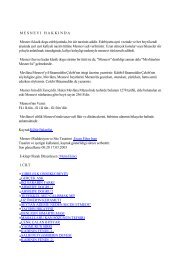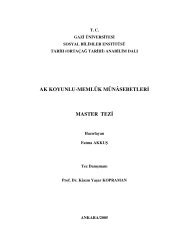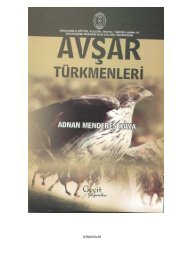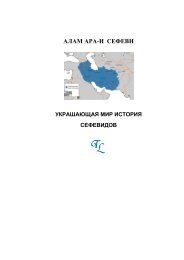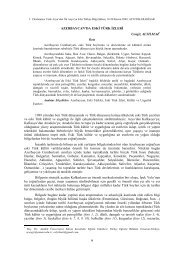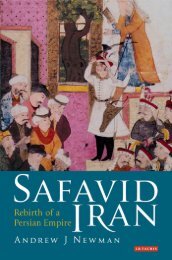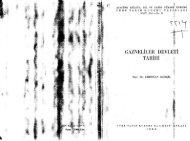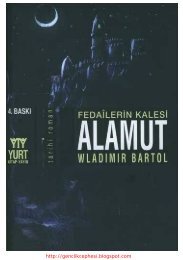War and Peace in Qajar Persia: Implications Past and ... - Oguzlar.az
War and Peace in Qajar Persia: Implications Past and ... - Oguzlar.az
War and Peace in Qajar Persia: Implications Past and ... - Oguzlar.az
- No tags were found...
You also want an ePaper? Increase the reach of your titles
YUMPU automatically turns print PDFs into web optimized ePapers that Google loves.
Build<strong>in</strong>g a new army 53<strong>and</strong>, as far as the tribal forces were concerned, loyalty to their chiefs <strong>and</strong>especially the hope of plunder. An ideological dimension was often given tomajor military campaigns by the declaration of a jihad.As campaigns were undertaken only dur<strong>in</strong>g the summer, the troops mostlymarched at night, with torches <strong>and</strong> music. Early <strong>Qajar</strong> armies were capable,on occasion, of cover<strong>in</strong>g large distances quickly. In 1795 Agha MohammadKhan marched with his cavalry from Tehran to Tiblisi (Tiflis) <strong>in</strong> 15 days.But the passage of an army was a catastrophe for the local populations. Whenon the march, the troops lived almost entirely at the expense of the <strong>in</strong>habitantsof the districts through which they travelled. The army <strong>in</strong>tendants gavereceipts for the supplies which the troops took, <strong>and</strong> the value of the supplieswas supposed to be deducted from the revenues due from the local population,but the reduction was rarely made, <strong>and</strong> the districts suffered almost asif they had been occupied by an enemy force. The sudden dem<strong>and</strong>s of a largenumber of troops for food, forage <strong>and</strong> transport threatened a rural populationsurviv<strong>in</strong>g on subsistence agriculture with a scarcity which might reachfam<strong>in</strong>e levels.In its struggle with the Russia <strong>in</strong> the late eighteenth–early n<strong>in</strong>eteenth centuries,Iran was able to campaign with a considerable degree of effectiveness.14 The early <strong>Qajar</strong> shahs were able to assemble large armies. Dur<strong>in</strong>g thefirst Russo-Iranian war (1804–1813) the Iranian forces were several times largerthan their Russian enemy <strong>in</strong> the eastern Caucasus, <strong>and</strong> European observerscommented on the skills of marksmanship <strong>and</strong> horsemanship displayed bythe cavalry. Their approach to fight<strong>in</strong>g was, to European eyes, undiscipl<strong>in</strong>ed<strong>and</strong> disorganized, resembl<strong>in</strong>g a tribal raid, <strong>and</strong> success was often dissipateddue to the troops ab<strong>and</strong>on<strong>in</strong>g the battle <strong>in</strong> order to loot. But, by us<strong>in</strong>g thetactics of tribal raid<strong>in</strong>g, the Iranians avoided the formal battles which wouldhave favoured discipl<strong>in</strong>ed forces, rely<strong>in</strong>g primarily on guerrilla raids, pick<strong>in</strong>goff small, isolated detachments, harry<strong>in</strong>g enemy communications <strong>and</strong> soon. With these methods the Iranian forces were able to deny victory to Russiafor n<strong>in</strong>e years, despite the latter’s immense superiority <strong>in</strong> size <strong>and</strong> resources. 15Early <strong>Qajar</strong> military reform: French <strong>and</strong> British missionsThe first attempts to <strong>in</strong>troduce European concepts of military organizationto Iran took place at the beg<strong>in</strong>n<strong>in</strong>g of the seventeenth century when ShahAbbas, tak<strong>in</strong>g advice from the British adventurers, the Sherley brothers, raiseda large force of <strong>in</strong>fantry on the European model armed with muskets. Yet,under Shah Abbas, battles cont<strong>in</strong>ued to be little other than large-scalecavalry engagements. In the eighteenth century Nader Shah, hav<strong>in</strong>g concludedthat the Europeans’ victories over the Ottomans were due to the discipl<strong>in</strong>e <strong>and</strong>order with which they fought, studied foreign methods, began to organizean artillery <strong>and</strong> entrusted the direction <strong>and</strong> comm<strong>and</strong> of newly raised <strong>in</strong>fantryto European, mostly French, officers. Nonetheless he too cont<strong>in</strong>ued to depend


